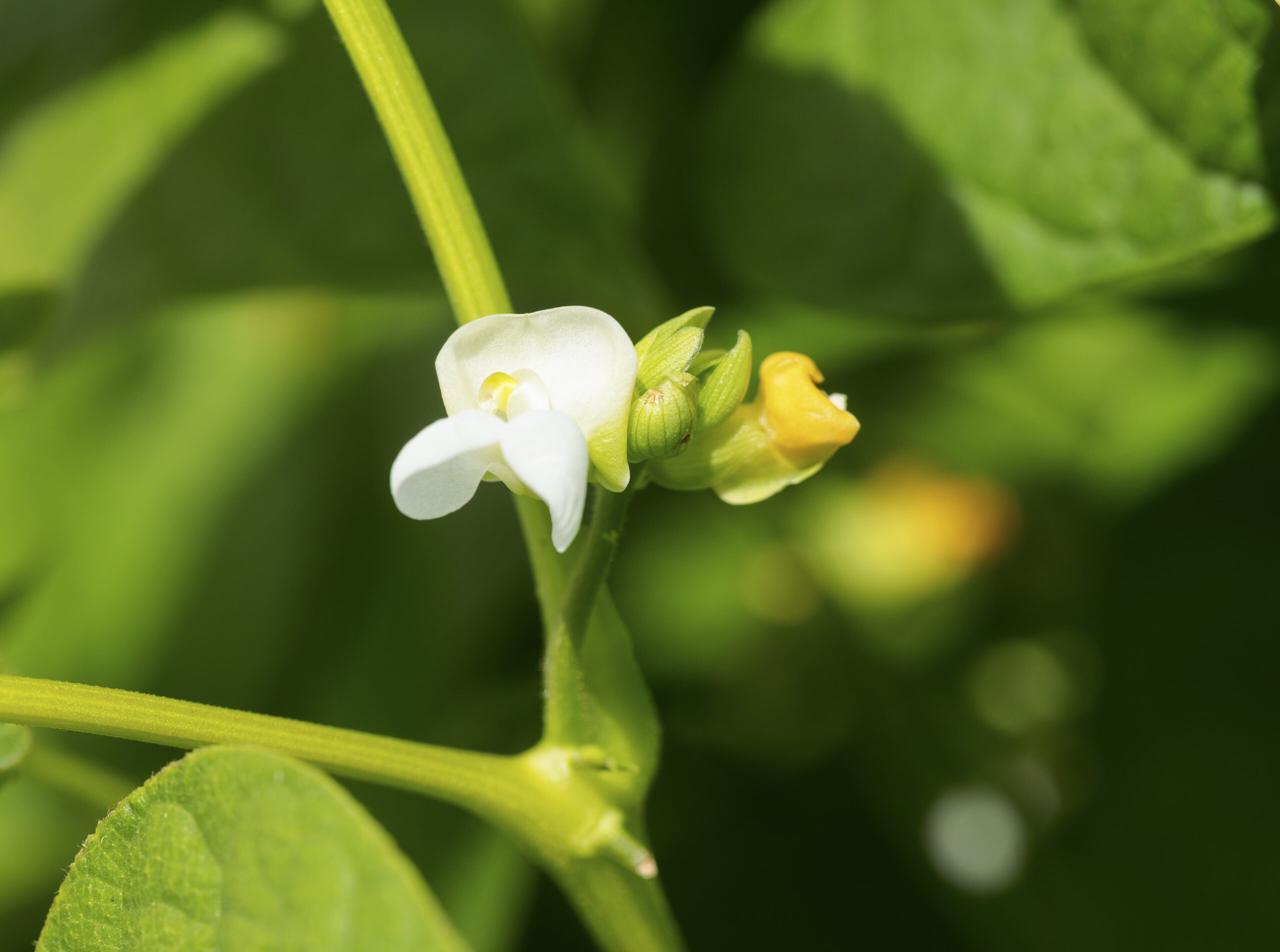Weed Management
Dry beans are not competitive and even low weed pressure can result in yield loss. Good weed control is important, as not only can weeds impact yields, but green weedy material can harbour diseases and cause quality issues by staining beans during harvest.
An integrated weed management strategy is important to reduce weed control issues, and a weed management plan should start a year or two before planting dry beans on a field. Herbicide options are limited in dry beans and choosing clean fields and controlling problematic weeds in the crop rotation before growing dry beans is important. Effective options for perennial weed control of weeds such as Canada thistle, perennial sow thistle, dandelions, and quack grass for dry beans are not available, so care should be taken to control these weeds in the rotation before growing dry beans. Dry beans are also very sensitive to many herbicide residues and herbicides used in rotation should be checked for cropping restrictions.
Dry beans are typically seeded after May 25 to avoid the risk of late spring frosts, and this presents a good opportunity to control weeds before seeding or before crop emergence in the spring. Herbicide selection should be done carefully and when choosing in-crop herbicides, growers should check labels before application, as not all herbicides have been tested on all dry bean types, and certain varieties will have different tolerance to herbicides.
If dry beans are grown in a row crop system, inter-row tillage is often used to help manage in-crop weed issues. Certain non-selective herbicides can also be sprayed inter-row as well. Inter-row cultivation should be done on warmer days when beans are limp and less likely to break if contacted, and when weeds will tend to wilt and die more quickly. Cultivation should occur when the canopy is dry to avoid spreading disease. Care should also be taken to avoid root pruning in later-season cultivations.
Related Resources
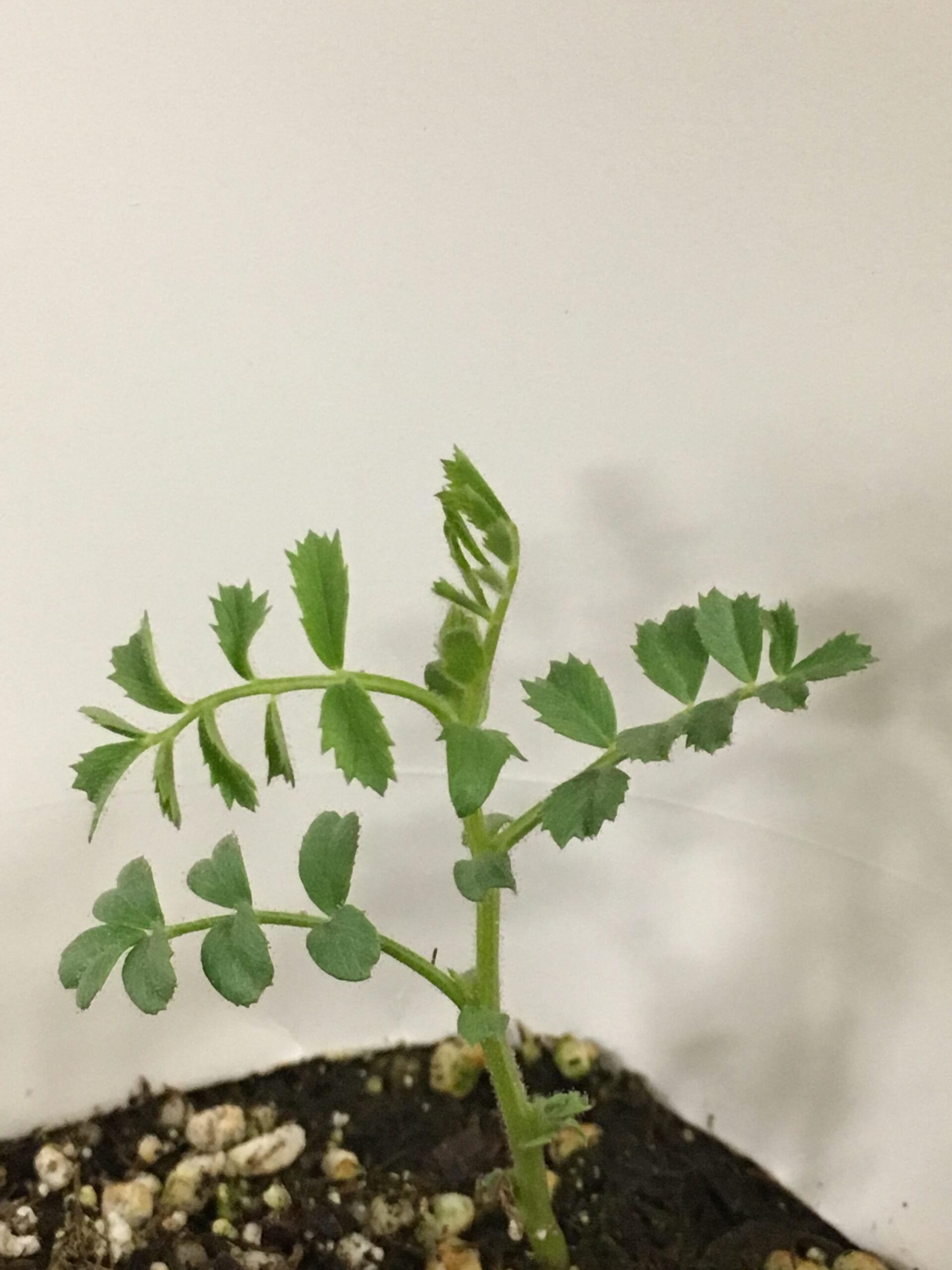
Staging Pulses for Herbicide Applications In-Crop
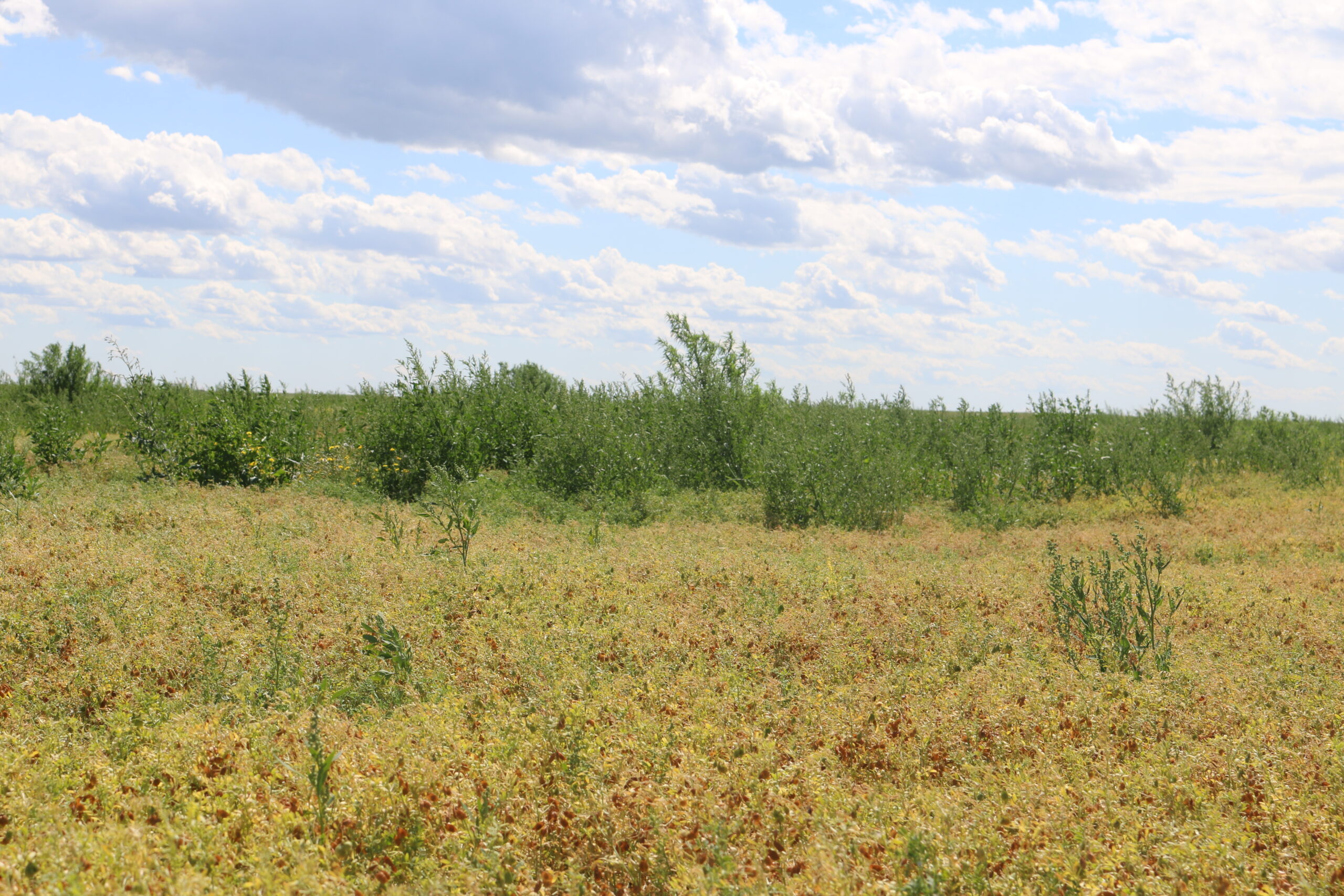
Critical Period of Weed Control in Pulses

Post-Emergent Herbicide Options for Dry Beans
Disease Management
Dry beans are susceptible to many different diseases, from seedling diseases that can be seed- or soil-borne, up to mature plant diseases. Both bacterial and viral infections can cause issues in dry bean growth, and careful scouting and management of the crop is important to correctly identify the pathogen affecting the crop.
Many management practices can reduce the risk of some diseases. Cultural control methods can play a large role in reducing disease pressure during the growing season. Growers should consider:
- Crop Rotation & Field Preparation: Follow a diverse rotation of at least four years between dry bean crops which can reduce pathogen loads in the soil, although there is no safe rotation length. In years where problems have been noticed, avoid planting adjacent to last year’s field to help avoid diseases spreading in from field margins. Plowing residue into the soil to avoid it scattering, and burying it will reduce the survival of the pathogens, but take care to avoid erosion issues.
- Seed Source & Handling: Plant clean seed that is disease free to avoid seed with bacterial blight. Seed should be handled gently both in storage and seeding operations to avoid damage to the seed coat.
- Variety Selection: Resistance to common blight and white mould is minimal. However, growth habits can affect how wet the canopy stays, greatly influencing the development of diseases like white mould. Choosing more upright varieties may result in a drier canopy with less disease.
- Weed Control: Keep the crop weed free, which will help reduce canopy cover and provide a drier canopy. Some weeds can host pathogens, increasing disease pressure.
- Proper Fertilization: Balanced nutrition is important to avoid nutrient deficiencies that may stress the plant and make it more susceptible to disease. Zinc deficiencies can result in more disease concerns. Over-application of nitrogen can also increase disease risk, as a lusher canopy can create a favourable environment for disease.
- Row Spacing & Tillage: Wider row spacing in row crops, compared to solid seeding systems, will have more airflow through the canopy, reducing disease pressure. If soil is compacted and hard, root diseases can be more problematic. Tillage near bean rows to break the soil up and allow improved root growth can reduce the severity of root diseases.
Seed treatments will help protect seeds and seedlings from seed-borne and soil-borne pathogens and help ensure the good establishment of a strong, vigorous crop. Foliar fungicide applications can be used to target identified diseases during the growing season at the correct timing to maximize effectiveness and protection of yield.
Dry beans can be affected by a complex of various root diseases including Fusarium, Rhizoctonia, and Pythium. Fusarium is the most common and most problematic in drier years. Symptoms include dark brown lesions on the tap root that can spread to all roots. Plants are stunted and yellow with fewer pods and smaller seeds. Rhizoctonia presents with chocolate to red-coloured spots that are more distinct and may have small black or brown sclerotia develop inside the stem. Aphanomyces euteiches has become more prevalent in Saskatchewan in the past few years with devastating effects on field peas. Dry beans have a variable response to Aphanomyces. They are not resistant, and can be a host, but will only produce a few oospores and have variable symptoms from the disease.
Longer rotations can help reduce disease pressure, however many of the pathogens will affect other crops as well (such as Rhizoctonia, Fusarium, and Pythium), so crop rotation will have less effect. Taking note of disease presence in previous years’ crops can help tailor seed treatment selections. Using good quality seed to encourage vigorous growth is also important. Avoid compacted soils with poor structure, as it will aggravate root diseases as root struggle to expand in tight soil.
Generally, rust is not commonly found in Saskatchewan. Bean types differ in susceptibility to rust, and it is much more common in pinto beans than in other types. Symptoms present as pustules on leaves with a yellow halo. Initially, the pustules are full of red summer spores and black winter spores do not develop until late in the season. Plants will become infected if they remain wet for 10 to 18 hours and in moderate temperatures of 16 to 25°C. The disease cycle will repeat every 10 to 14 days, and is usually most severe in late-planted, heavily fertilized beans, with thick canopies.
Early infections that are severe will be devastating to the crop. There are foliar fungicides registered for the control of rust. Infected straw deep plowed into the soil soon after harvest and following a minimum of three-year crop rotation will help decrease the pathogen load for following crops.
Blights are most prevalent in wet, windy weather and can be spread by rain splash. Damaged or cut tissue is particularly susceptible to infection. Blights will result in leaf lesions, defoliation, pod lesions, and shrunken discoloured seed. In Saskatchewan, the two most common blights that will affect dry beans include common blight (Xanthomonas campestris pu. Phaseoli) and halo blight (Pseudomonas syringae pv. Phaseolicola). Common blight is characterized by large, irregularly shaped lesions surrounded by a chlorotic halo. Veins near the lesions are darkened and pods will develop a greasy-looking spot also surrounded by a chlorotic halo that will ooze yellow when wet. Less prevalent is halo blight which starts as small, water-soaked spots that die leaving chocolate brown lesions with a light green halo around them, and pod lesions will ooze a white/cream colour when wet. Pinto, great northern, and red Mexican bean varieties have some tolerance to halo blight.
Both blights are seed-borne, and soil residue-borne, so using disease-free seed is very important. Proper rotation will help lessen pathogen load as well. Streptomycin seed treatment has been used to reduce seed-borne bacterial diseases when importing seed from the United States. However, streptomycin is not registered for use in dry beans in Canada and starting in 2018 there may be further restrictions on importing streptomycin-treated dry bean seed. Copper fungicides can help control blights in season but are ineffective when wet weather favours the development of the disease.
White mould is a serious disease of dry beans in Saskatchewan, as with many crops (such as canola, mustard, sunflowers, and other pulses), meaning the pathogen is often present. Prolonged wet conditions favour the development of the disease, and irrigated beans that are solid-seeded are at high risk. Beans are grown in production systems with more airflow through the canopy to help keep them dry will help reduce the pressure of white mould.
White mould spores land on petal tissue that is dying and falls into the leaf axils on the plant. It then develops a watery lesion and often fuzzy white mould growth. Depending on the timing of the infection, it spreads into the stem and can completely girdle the stem, resulting in poor seed production and premature plant death. Small black sclerotia bodies will form inside the stems that will fall to the soil to produce spores in the following years.
Foliar herbicides are registered for control but should be applied to cover petals before disease symptoms are visibly seen. Production practices that help dry the canopy out will also reduce the virility of the disease.
The pathogen causing Anthracnose in dry beans is specific to dry beans and does not affect other pulse crops. Generally, it is not a common concern in Saskatchewan and can be avoided by using disease-free seed and following a minimum three-year crop rotation, as it is seed- and soil-borne.
Other concerns in dry beans may appear to be diseases but are abiotic or viral and fungicides are ineffective in managing them. It is important to accurately identify the cause of symptoms to ensure the correct management steps are implemented.
Bean common mosaic virus can be spread by infected seed or by sap-feeding insects such as aphids. Affected bean plants are stunted, spindly, have few pods, and may be off-colour. Leaves may be puckered, wrinkled, or elongated. While infections seldom cause plant death, the impact of yield will depend upon the time of infection, with earlier infections having a greater impact.
There is varietal resistance in some bean types, and using clean seed will help prevent issues.
Dry beans are susceptible to damage from sunscald and ozone damage, which results in bronzing. Sunscald is caused by the intense concentration of the sun’s heat on plant tissue. It can affect leaves, stems, or pods and most often is found on lush new growth. Affected leaves look brown and scorched or show white discolouration. The leaf tissue will die and crumble, leaving ragged edges on the leaves. When there are humid, warm, cloudy days followed by bright sun, leaves are most susceptible to damage.
Bronzing occurs when leaves are exposed to ozone. Ozone exposure is related to pollution and lightning events. Similar conditions that favour damage from sunscald also favour damage from higher concentrations of ozone. Leaves will exhibit small reddish-brown flecking on upper surfaces and some pods may show flecking as well. Some varieties are more sensitive to ozone damage, with black varieties more likely to be damaged. Neither condition is considered to affect yield.
Various nutrient deficiencies can appear to be diseases at first glance. Zinc deficiencies may show up in dry beans and can sometimes mimic some diseases or environmental symptoms. Dry beans experiencing zinc deficiencies will have yellowing of the new leaves in between leaf veins that will remain green. The bean plants will have shorter internodes and can appear to be stunted. The top leaves may start to curl under and have a bit of a bronzed appearance.
Fungicide Resistant Disease Populations
Just as with different herbicide groups, fungicide groups also have the potential to develop resistance in the disease population. Any fungal pathogen population may contain some strains naturally insensitive to various fungicides. A gradual or total loss of disease control may occur if these fungicides are used repeatedly in the same fields. Other resistance mechanisms that are not linked to the site of action, but are specific for individual chemicals, such as enhanced metabolism, may also exist.
To delay fungicide resistance/insensitivity:
- Where possible, rotate fungicide groups.
- Where possible, tank mix fungicides that have a high risk of developing insensitivity with fungicides from a different group.
- Do not apply more than the maximum number of applications listed on the label.
- Avoid consecutive sprays of the same fungicide, or other fungicides in the same group, in a season.
- Fungicide use should be based on an integrated pest management (IPM) program that includes scouting and accurate record keeping of fungicide use and crop rotation.
- An IPM program also considers cultural, biological, and other chemical control.
- Monitor treated fungal populations for signs of fungicide insensitivity. If the disease continues to progress after treatment, do not reapply the same product at a higher rate.
- If you observe fungicide insensitivity, discontinue the use of the product and switch to a fungicide with a different mode of action.
- Contact your local regional crop specialist or certified crop advisor for any additional pesticide management and/or IPM recommendations for specific crops and disease problems in your area.
Fungicides
Use foliar fungicide only when disease risk and potential loss are economically damaging. Applying fungicides for the wrong problem or at the wrong time will greatly reduce economic returns and can limit control options for later in the season if disease risk increases.
Resistance of several fungal pathogens to strobilurin fungicides (Group 11) has been reported in Saskatchewan. No more than two applications per year of any strobilurin fungicide should be made to the same field. The continuous use of strobilurin fungicides without fungicide rotation greatly increases the threat of disease resistance.
Related Resources
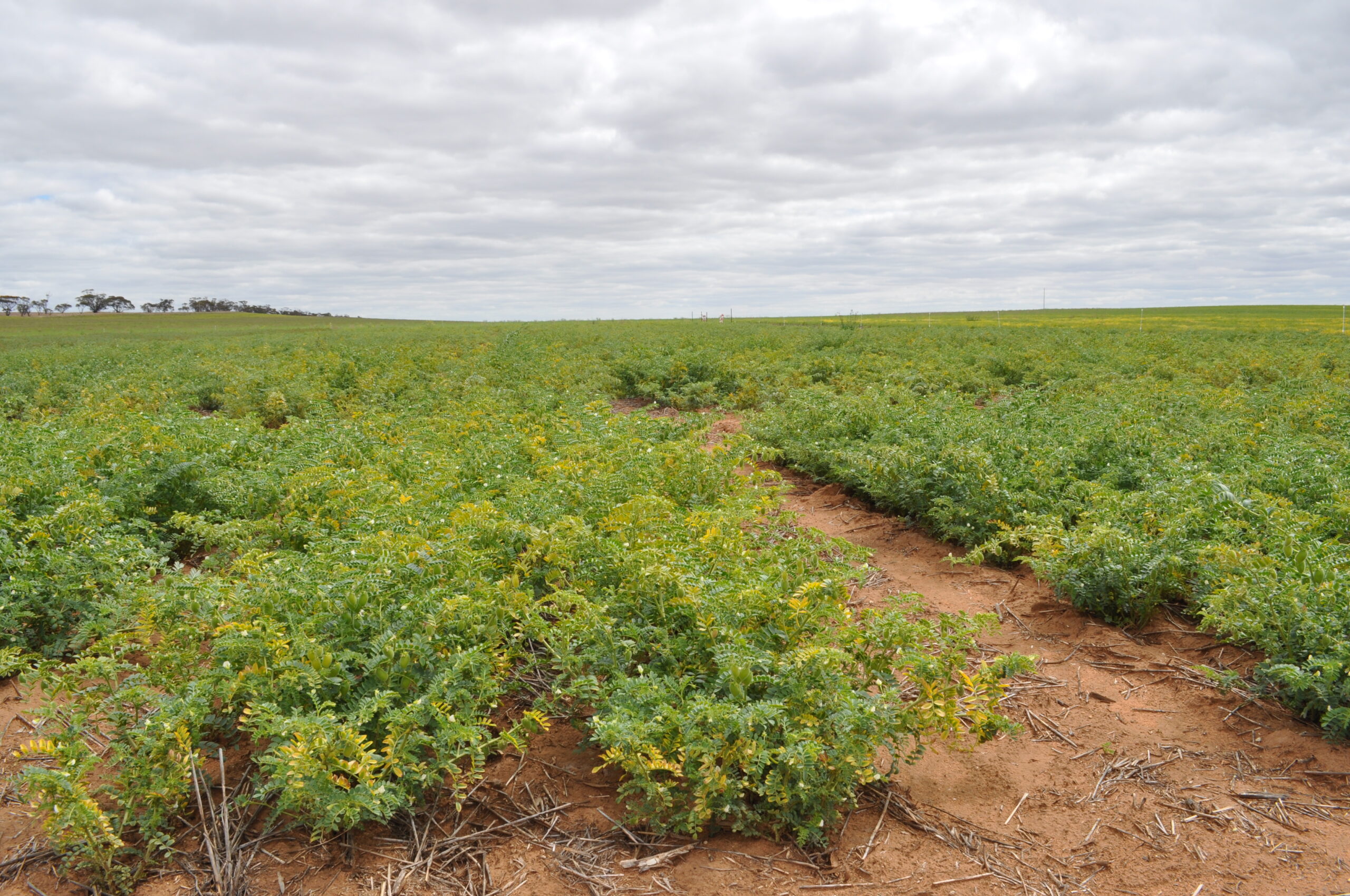
Viruses in Saskatchewan Pulse Crops
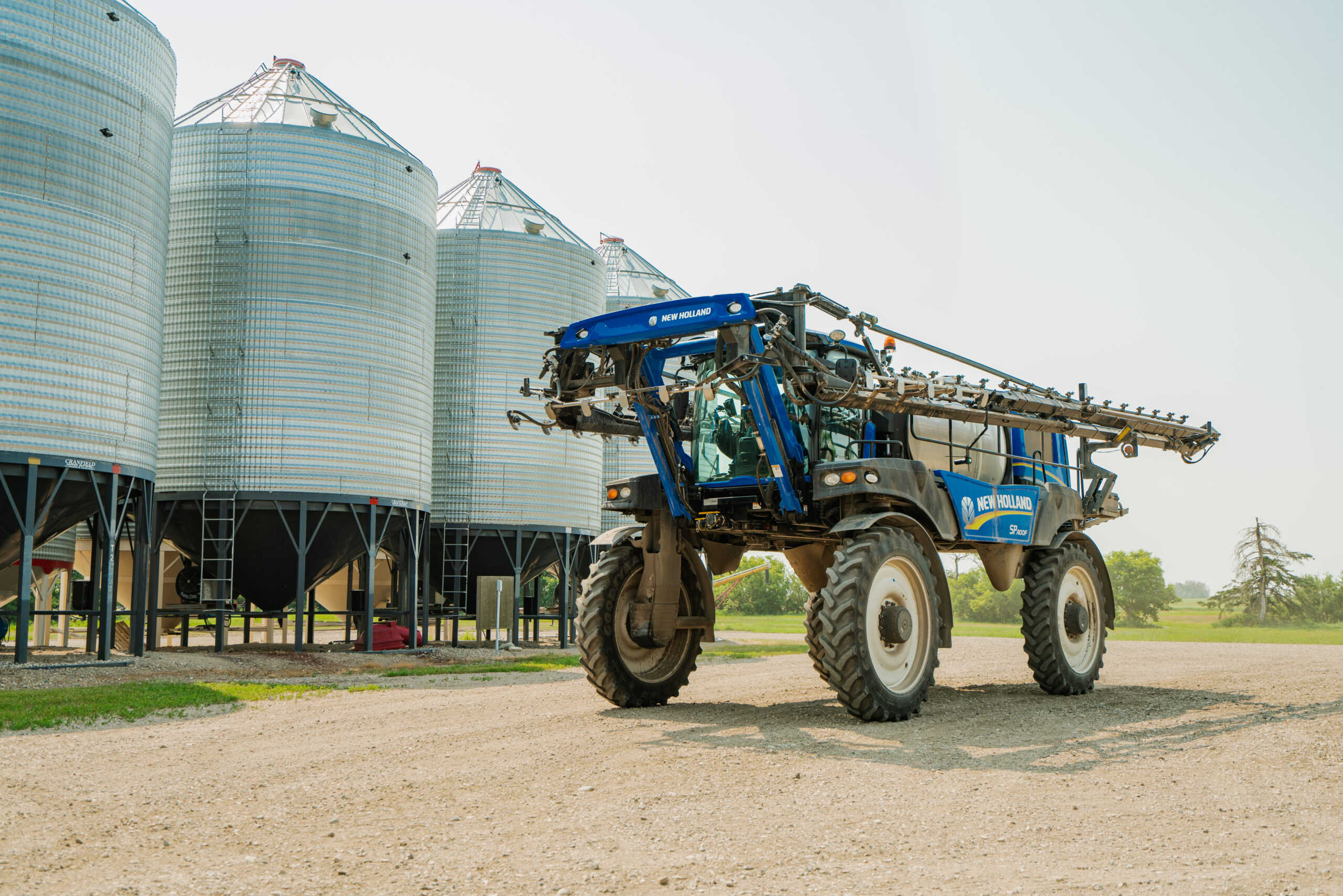
Dry Bean Fungicide Options

Pulse Agronomy Webinar: Dry Bean Production in Saskatchewan
Insect Management
Insects of concern in dry beans include below-ground feeders, sap feeders, as well as defoliators. Crops should be scouted throughout the growing season to monitor for damage and control measures only be taken if economic thresholds are reached to help protect beneficial insects present in the field. The resources below show the most common insect pests of dry beans, and the insecticide products available to help control them if populations are at levels where economic damage will occur.
A variety of different aphids can be present in many crops. Occasionally, pea aphids will become a significant pest of dry beans in Saskatchewan. Adult pea aphids are 3 millimetres (mm) long, light green, with long legs, and can be wingless or have translucent wings. Aphids rarely overwinter in Saskatchewan, although occasionally some eggs may survive, attached to crop residue in alfalfa and clover fields. These eggs hatch in early spring and later generations with wings, in May, or early June, may migrate to annual crop fields. However, most pea aphids blow in on warm southerly winds from the United States in June or early July.
Depending on weather conditions there may be from seven to 15 generations per season, and if conditions favour multiple generations, then populations may increase to levels where control is warranted. Natural pests such as the ladybird beetle, minute pirate bug, damsel bug, syrphid fly larvae, and several parasitic wasps can help control populations. In warm moist weather, fungal disease can also affect aphids.
Being only an occasional pest in dry beans, there are no established economic thresholds for this pest.
Alfalfa loopers are occasional pests of dry beans and are more common when grown near alfalfa. Loopers either overwinter in the soil as pupae or adult moths get blown up from the United States in early summer. Generally, there are two or three generations per year, and they may overlap as some may overwinter and some blow in. Loopers may defoliate and clip flowers resulting in yield loss. There is no economic threshold established in dry beans, however, other crops recommend control when populations exceed 15 larvae per metre squared, and heavy defoliation and flower clipping occur.
Cutworms are the larvae of several different types of moths, and they overwinter in the soil as pupae. Larvae emerge from the pupae in the spring and feed on new plants. There are many different species of cutworms in Saskatchewan, and they can affect and eat many different types of crops. Dry beans are no exception and can be cut off below the soil surface by cutworms. Dry beans do not have growing points below ground and therefore cannot regrow after being cut off by cutworms. Crops should be scouted regularly in early spring, and if dead wilted plants are observed, the soil around and up the row from the plant should be examined for the presence of cutworms. The feeding behaviour will vary depending on species, but most feed at night and will be below the soil surface, up to a depth of two inches during the day.
Grasshoppers feed on the foliage of almost any crop, dry beans included. Field edges usually have higher infestations as they move in from field borders. Significant defoliation and yield damage can occur, especially if the other crops surrounding have matured and the dry beans are still immature, which increases the migration of grasshopper populations to the field.
Lygus bugs are not often a significant pest of dry beans, however, if the weather is hot and dry it can favour the buildup of populations and increase the potential for damage to early growth. Lygus bugs feed on plant sap and have piercing, sucking mouth parts. If heavy feeding occurs, they can disrupt the flower set and cause pod abortion. Direct feeding on maturing beans can cause surface pitting, with the potential to affect the quality of the beans. Nymphs tend to be more problematic than adult lygus bugs. A laboratory study in Manitoba found in early reproductive stages, one lygus per inflorescence could reduce yield, primarily by causing pod abortion. At later stages, three lygus per inflorescence was required to affect yield. However, a concurrent field survey of fields with lygus bugs in Manitoba from 2008 to 2010 showed little economic effect of lygus bugs feeding on dry beans.
Potato leafhoppers are small (18 in), pale green, wedge-shaped bugs that move rapidly by jumping. Young nymphs are paler green, lack wings, and walk distinctively sideways when disturbed. Eggs are laid on the plant leaves and hatch in 10 days. Populations increase through the growing season and can get to economic threshold levels by July. Dry bean plants get ‘hopper burn’ from both adults and nymphs sucking sap from plants. Viruses can be transmitted to the plants from their feeding, as well with affected plant tissue becoming dwarfed, crinkled, and curled. Brown areas begin to appear on leaf margins and plants may eventually die.
Treatment is warranted when one leaf hopper per trifoliate leaf is found. A sweep net can provide detection of the hopper but scouting individual plants should be done to determine thresholds. Placing your hand under the leaf will cause them to run to the upper side of the leaf.
Sometimes in warm, moist conditions, fungal pathogens can help control this pest, but predators and parasites tend to play a minor role in helping to control populations.
The adult seedcorn maggot looks like a common house fly and will emerge from eggs in the soil in late May. The adult then lays eggs in moist cracks in the soil that hatch after two to four days when temperatures are 10°C. Larvae are white, tough-skinned, and roughly a quarter inch long. They will burrow into both the seed and the stem of developing dry bean plants, resulting in thinned stands and wilted plants. Damage is worse when germination and emergence are delayed, so ensuring planting as early as possible into a warm, shallow seedbed encourages fast emergence and will help limit the damage. Sprays are not effective and seed treatments are the only control registered to protect against the seedcorn maggot.
Wireworms are small segmented, tan-coloured worms that live in the soil and will feed on a variety of plant hosts. Adult wireworms are beetles that do not do economic damage to crops. Larvae will migrate near the germinating soil in early spring and move back down deeper in the soil as soil temperatures climb, later in the summer. Damage can be seen in the field by wilting plants resulting from wireworms chewing on the stems and may appear similar to cutworm damage. The distinction is that wireworm feeding often looks more like the stem is shredded and it is usually still attached to the roots, whereas with cutworm feeding the stem is cut right off. There are seed treatments available to control wireworms, as they cannot be controlled by foliar sprays as they stay below ground.
